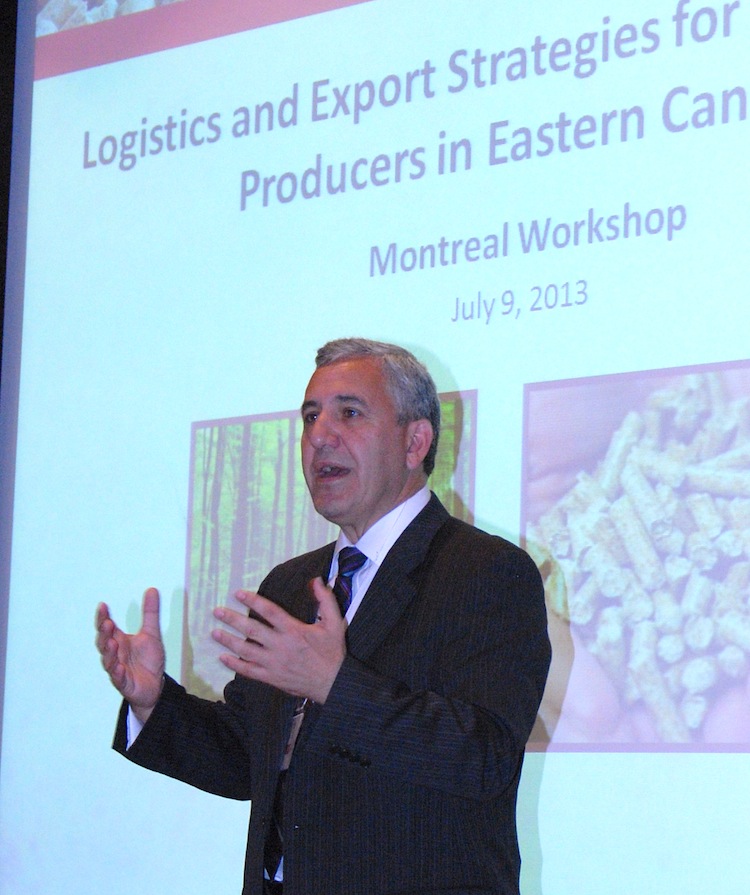
Optimizing eastern pellet exports
July 15, 2013
By Carroll McCormick
 July 15, 2013 - Eastern Canadian wood pellet
producers flocked to the first ever workshop organized to discuss the export logistics
challenges they face. They learned that co-operating to provide high-volume
shipments is critical for greasing the supply chain.
July 15, 2013 - Eastern Canadian wood pellet
producers flocked to the first ever workshop organized to discuss the export logistics
challenges they face. They learned that co-operating to provide high-volume
shipments is critical for greasing the supply chain.
Players such as CN,
Canfornav and ports from Montreal to Halifax told the participants they want their
business.
Nearly 100 participants attended the Eastern Canadian Pellet
Logistics Workshop last week, organized by the Quebec Wood Export Bureau (QWEB) and the
Wood Pellet Association of Canada (WPAC). The topic was how to make the
logistics of transporting wood pellets – particularly to the European Union
market – more attractive to shippers.
Participants first got a reminder of how things are done in
Western Canada. Gordon Murray, executive director, WPAC, referred to a spirit
of co-operation among western producers. The leadership of the big producers, co-mingling
and economies of scales help account for 1.6 million tonnes of wood pellets
being shipped out of Port Metro Vancouver in 2012.
Participants learned that they too could become big exporters
if they organize to reduce the cost of transportation by providing attractive
volumes to shippers, and by offering high-volume, long-term contracts to
European Union customers.
Jean-François Arsenault, principal, CPCS, presented findings
from a study that the QWEB and WPAC commissioned. CPCS was tasked with
analysing the transport chain for exporting wood pellets from Eastern Canada,
and identifying barriers to implementing an efficient, optimized supply chain. In
brief the study concluded that the market is there for Eastern Canadian
producers to export nearly all of their current annual production. The
challenge, however, is how to increase volumes and thereby decrease freight
rates.
The European Union market consumed 19 million tonnes of wood
pellets in 2012, and has a forecasted annual growth of 10 per cent. "There are huge
opportunities, for example, 15 to 20 per cent annual growth in Italy," Murray noted.
"We
believe that Eastern Canada has the potential to be as big as Western Canada,
but what has been holding us back is a fragmented supply, which raises our
costs," said Matthew Griffin, commercial manager, Drax, which owns and
operates a 4,000 megawatt power station in North Yorkshire, England.
The CPCS study calculated that moving wood pellets by rail is
almost always less expensive than by truck. That said, Arsenault pointed out
that the majority of producers have no access to rail spurs and they would
likely have to buy or lease rail cars. Arsenault touched on other issues too,
such as the possibility of short sea shipping to move pellets to coastal ports
and the need for a dedicated dockside pellet terminal.
Speaking of ships, Knud Jensen, executive vice-president,
Canfornav, offered a graphic example of the economy of scale. "Comingling cargo
is in its infancy, but it would help in getting rates down. The freight
difference between a 40,000-tonne load and a 30,000-tonne load will be 15 to 25 per cent."
Too, he added, "We will look at freight rates much differently on a long-term
strategy than on the spot-market."
CN's Uri Szyk, market manager, sales & marketing,
industrial products took the podium to remind listeners that CN was ready to
help producers move their pellets to market. CN is interested in exploring
capital investment opportunities, including building track infrastructure.
Representatives from four ports – Montreal, Trois Rivière,
Belledune and Halifax – presented their credentials for moving wood pellets and
their connections to other transportation modes. The Port of Trois Rivières,
for example, is in expansion mode. "We are open to suggestions to smaller
producers getting together and opening a wood pellet terminal," noted Matthieu
Gauthier, the port's business development co-ordinator.
Patrick Bohan, manager, business development, Port of Halifax,
noted that its grain elevator is used to handle wood pellets. "This is not at
the concept stage. It is real and operating 24/7/365."
Rayburn Doucett, president and CEO, Belledune Port Authority
said, "We are shipping over 100,000 tonnes a year of pellets. We have a
terminal dedicated to wood pellets. We can put our product into Europe as cheap
or cheaper than any other port."
Antonio Boemi, vice-president, growth and development, Port
of Montreal, said this about the vessels that call at the port. "Vessels do
full unload and load [here]. This leads to more balanced trade and better
costs."
Rentech, whose business includes supplying wood pellets to
Drax and Ontario Power Generation, spoke of issues ranging from plants to ports,
including a deal with Quebec Stevedoring to build handling equipment and 75,000
tonnes of pellet storage space by 2014 at the Port of Quebec, exclusively for
Rentech. Rentech extended this offer: "… we are able to consolidate volume and
provide a conduit for other producers to the export marketplace."
Perhaps, suggested Bruce Lisle in a conversation with Canadian Biomass, "Rentech could be a
comingling leader."
Pierre-Olivier Morency, manager, wood pellets, QWEB &
director, market access and promotion, WPAC, told Canadian Biomass, "Strong interest was demonstrated during the
members-only session to work together and develop solutions. I think that WPAC
is setting a strong mandate to go forward with a logistics project in Eastern
Canada."
that makes sense." (Jim Vena, executive vice-president & chief operating
officer, CN)
Print this page